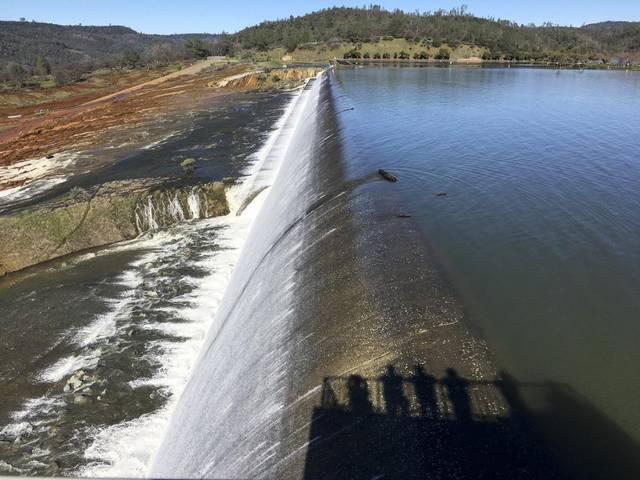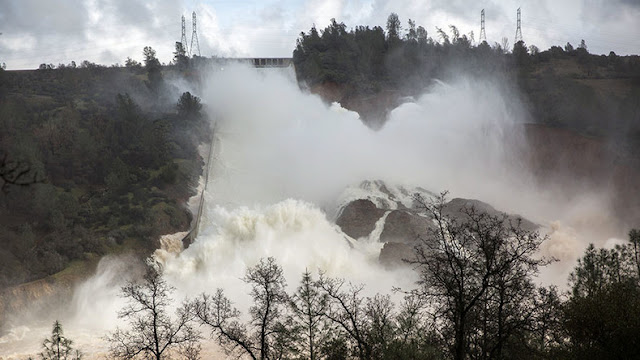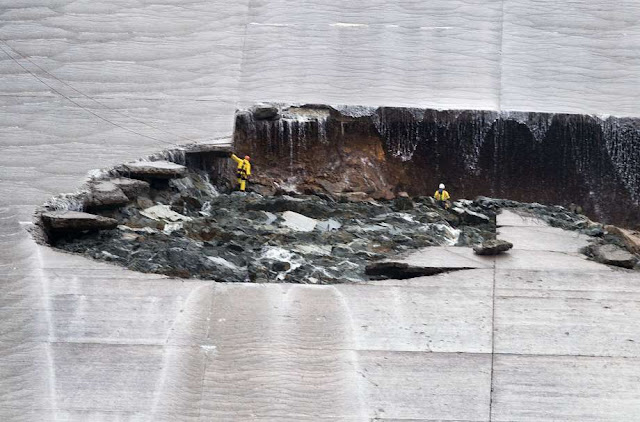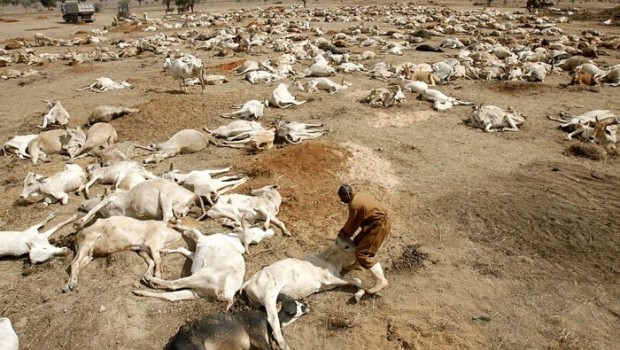- Mass Death of Seabirds in Western U.S. 'Unprecedented' as tens of thousands dead due to deadly patch of warm water along the American West
- Crippled Oroville Dam overflowing emergency spillway’s! A perilous situation confronting the operators of California’s second-largest reservoir
- More whale horror after 400 whales stranded on a beach in New Zealand resulting in 300 deaths 240 more arrive
- Millions of African's face starvation after "Super El-Niño" causes drought throughout the continent killing millions of cattle and destroying crops
| Mass Death of Seabirds in Western U.S. 'Unprecedented' as tens of thousands dead due to deadly patch of warm water along the American West Posted: 12 Feb 2017 01:10 AM PST Photo University of Washington 2015 and 2016 were the two hottest years ever recorded; we should not be surprised therefore to find our oceans to be showing signs of stress as the delicate balanced eco system is also being stretched to its limit. A deadly patch of warm water along the American West coast called the ‘Pacific blob’, stretching all the way from California up to the Gulf of Alaska, Has killed thousands of California sea lions in 2015. Many starved as they struggled to find food in an unusually warm eastern Pacific. Strange exotic tropical fish have been reported off the coast of Alaska. In the winter of 2015 blue-footed diving seabirds called Cassin’s auklets, have been washing up dead by the thousands on beaches from San Francisco to Alaska, it is thought more than 250,000 died from lack of food. An unprecedented die off which began in 2011 along the West coast of North America when billions of sea urchins and sea stars died suddenly in what was 'one of the most unusual and dramatic die-offs marine biologists have ever recorded.' The Culprit: Warm Water? Bill Sydeman, a senior scientist at California's Farallon Institute, said he believes the most likely scenario is that the deaths are related to a massive blob of warm water that heated the North Pacific last year and contributed to California's drought and to 2016 being the hottest year on record. That water was hotter and stayed warm longer than at any time since record-keeping began. It stretched across the Gulf of Alaska, where a high-pressure system blocked storms, preventing the water from churning to the surface and mixing with air. More warm water eventually moved inward along the coast as far south as California, altering how favorable the environment was for the zooplankton that many fish and birds, including Cassin's auklets, feed on. Last year tens of thousands of common murres were the victims, an abundant North Pacific seabird, starved and washed ashore on beaches from California to Alaska, researchers have pinned the cause to unusually warm ocean temperatures that affected the tiny fish they eat. A year after tens of thousands of the common murres died, John Piatt, a research wildlife biologist for the U.S. Geological Survey claims the deaths of the common murres is an indicator of the regions' health. Elevated temperatures in seawater affected wildlife in a pair of major marine ecosystems along the West Coast and Canada, said "If tens of thousands of them are dying, it's because there's no fish out there, anywhere, over a very large area," Piatt said. It is thought 500,000 of the common murres, who look like thin penguins, died last year all though this could be just a conservative guess because only a fraction of the dead birds likely reached the shore. Home |
| Crippled Oroville Dam overflowing emergency spillway’s! A perilous situation confronting the operators of California’s second-largest reservoir Posted: 12 Feb 2017 12:19 AM PST Photo Sacramento Bee Sent in by Chessie Crowe Gartmayer
Only just over a month ago California was at the back-end of a miserable 5 year drought, just 40 odd days later empty reservoirs are overflowing emergency spillway’s leaving residents and water authorities very worried. The Oroville Dam California’s second-largest reservoir has for the first time since it was completed in 1968, begun spewing water from its storm-swollen reservoir overtopping the emergency spillway Saturday, sending sheets of water down a forested hillside and adding to the murk and debris churning in the Feather River below. The emergency releases underscored the perilous situation confronting the operators of California’s second-largest reservoir for the rest of this extraordinarily rainy winter. Photo RT.com Unable to release enough water from the dam’s 3,000-foot main spillway, which split open Tuesday and continues to erode, the California Department of Water Resources announced that storm waters reached the top of the dam at around 8 a.m. Saturday and began flowing over the concrete lip of the adjacent emergency spillway onto a wooded ravine below reports the Sacramento Bee. The flow began as a steady, smooth spill across the 1,700-foot-wide lip of the emergency structure, and was expected to peak at 6,000 to 12,000 cubic feet of water per second at around midnight Saturday. With dry weather in the near-term forecast for the Sierra and inflows to the reservoir slowing, the lake level should fall below the emergency spillway as of Monday night, said Doug Carlson, a DWR spokesman. Photo Metabunk But the crisis at Lake Oroville won’t abate any time soon. Northern California is on pace for its wettest winter ever, and Croyle said an estimated 2.8 million acre-feet of snow blankets the Sierra above the dam. Depending on how quickly that melts, it will put additional strain on Oroville Dam in the months to come. “Our next 60 to 90 days will be critical, how we route this (snow) runoff through this reservoir,” Croyle said. “There’s a lot of snow up there.” At various vista points in Oroville, a community of 15,000 just downstream of the dam, residents gathered under clear skies to gape in awe at the Feather River, so infused with mud and debris it resembled liquid clay as it tore through its channel. Longtime resident Tom Oxford, 55, took in the view from a residential ridge on Mira Loma Drive, where the river surged beneath a railroad trestle. He took note that the trestle and levees on both sides were holding, with heavy moss rock that had been there for decades undisturbed by the fast-moving water. Still, the sight was piercing. “We’ve never seen the river that brown before,” Oxford said, “and I’ve been here 50 years.” Home |
| More whale horror after 400 whales stranded on a beach in New Zealand resulting in 300 deaths 240 more arrive Posted: 11 Feb 2017 06:13 AM PST Photo ABC An absolute disaster has struck New Zealand after around 400 whales were found thrashing tales in distress and stranded on a beach on Thursday causing the death of around 300 whales, the situation worsened this morning when another 240 arrived in the same place causing more chaos for the many volunteers trying desperately to refloat the desperate whales. Earlier on Saturday, volunteers had refloated some 100 of the more than 400 pilot whales which beached on Thursday. But a human chain, with volunteers wading neck-deep into the water, failed to prevent a fresh pod making landfall. Photo Los Angeles Times The stranding now involving around 640 whales is thought to be one of the worst ever in the world. More than 300 of the 400 original arrivals died while medics and members of the public tried to keep survivors alive by cooling them with water. It is hoped that those of the new arrivals that survive can be moved back out to sea during the next high tide in daylight on Sunday. It is not clear why the whales continue to arrive on the 5km-long (three miles-long) beach next to Golden Bay. One theory is that they may have been driven on to land by sharks, after bite marks were found on one of the dead whales. Photo Gizmodo Herb Christophers of New Zealand's department of conservation told the BBC that the whales were trying to get round the top of South Island, but if their navigation went wrong they ended up on the beach. In the shallower waters, the animals' use of echolocation was impaired. "It's a very difficult place if you get lost in there and you are a whale," he said. Home |
| Millions of African's face starvation after "Super El-Niño" causes drought throughout the continent killing millions of cattle and destroying crops Posted: 11 Feb 2017 03:52 AM PST Dead cattle litter the ground in drought ridden Ethiopia Photo Orthodox Christian Network Kenya's president has declared the drought, which has affected as much as half the country, a national disaster. Uhuru Kenyatta appealed for international aid and said the government would increase food handouts to the most needy communities. Kenya's Red Cross says 2.7 million people face starvation if more help is not provided. Other countries in the region have also been hit by the drought, blamed on last year's El Nino weather phenomenon. In Somalia, nearly half the population, over 5 million, is suffering from food shortages and the UN says there is a risk of famine in several parts of the country. During the last drought on this scale in 2011, famine killed about 250,000 Somalis. In a statement, Mr Kenyatta said the government had allocated $105m to tackle the drought which has affected people, livestock and wildlife in 23 of Kenya's 47 counties. "Support from our partners would complement government's efforts in mitigating the effects of drought," he said. Mr Kenyatta added that all purchases of food and other items would be made in a transparent way. "I will not tolerate anybody who would try to take advantage of this situation to defraud public funds," the president said. An El Nino weather pattern, which ended in May, triggered drought conditions across the southern and eastern African region that hit the staple, maize, and other crops and dented economic growth. More than 1 million people in drought-hit southern Madagascar are experiencing "alarming" levels of hunger, and more aid is needed to prevent a dire situation from becoming a "catastrophe", UN agencies said on Thursday. This is the latest warning by the agencies who have been scaling up their response to a crisis affecting more than half the population in the south of the island nation. Some 20% of households in the affected areas are now experiencing emergency levels of hunger, according to the latest food survey. Meanwhile as South Africa contends with a severe drought, officials at Kruger National Park have put a plan into action that they say will help avert mass die-offs of wildlife-through the selective culling of some of the park's largest grazers. This week, rangers began killing around 350 of the park's 7,500 hippos and 47,000 buffalo. The populations of both species are at their highest ever, according to officials. Reducing their numbers will not put either species at risk, rangers say, but will reduce some of the strain on the park's grasslands and water holes. Zimbabwe is one of many countries feeling the strain of El Nino, which has dried up rainfall across southern Africa over the last year, killing crops, disrupting hydropower production and forcing local water authorities to enforce stringent water rationing in some areas. More than 5 million people are facing food and water shortages. Livestock experts say parched pastures are causing the deaths of thousands of cattle across the country. Last year, the agriculture ministry’s livestock department estimated that the national cattle herd stood at 5,3 million animals, down from over 6 million in 2014. In one district in Masvingo province last year, more than a thousand cattle died because of drought, according to the Ministry of Agriculture. |












» utube 11/21/24 MM&C MM&C News Reporting-Global Trade-Best Route in World-Purchase Power-Justice-Cen
» Koger: The budget schedules have not reached us yet, and we will start the sessions as soon as they
» MP calls for activating China's Belt and Road Initiative economy
» Al-Baldawi: Political will controls the fate of the ministerial amendment
» Al-Lami: US bases in Iraq represent a military arsenal to protect the entity
» Iraq sends "identical" messages to international and Arab parties regarding Israeli threats
» Iraqi parliament resumes sessions on Monday with 'important' laws
» The Central Bank of Iraq sells more than $894 million in three days
» With the participation of the private sector.. Iraq studies a project to establish a large medical c
» OPEC Secretary General: Crude Oil and Natural Gas are 'Gifts from God'
» How much did the census cost in Iraq?
» Türkiye hints at “good news” regarding Kurdistan oil exports.. What about the development path?
» Minister of Education: Project No. 1 has reached its final stages and new schools will be announced
» With Al-Mashhadani's support... Parliamentary move to activate the oversight role during the upcomin
» Israel sends messages to Iraq: An expected strike and no options for deterrence
» A government bank in Karbala embezzles installment amounts paid by a number of borrowers
» Iraqi government begins measures to prevent oil “smuggling” from Kurdistan
» Iraq sends "identical" messages to international and Arab parties regarding Israeli threats
» Al-Araji: The international coalition has great credit in helping Iraq defeat ISIS
» Dollar price stability in Iraq
» Trade announces a special application for the ration card that determines the mechanism for families
» Iraqi exhibitions participate in the UFI conference in Germany
» Industry: A plan to increase battery production and cover the needs of the local market
» Health: We are studying the establishment of medical cities in Baghdad and the governorates with the
» Foreign Minister: The government has taken internal and external steps regarding the threats of the
» Immigration: Report to be submitted next month to curb illegal immigration
» The Arab League will hold a meeting next Sunday to confront the threats of the Zionist entity, at th
» Iraq comments on the threats of the Zionist entity
» Al-Mandlawi: The International Court’s decision to arrest Netanyahu and his defense minister is a st
» Supreme Census Authority: End of the second phase of the population census
» An inside look at Iraq’s “fuel smuggling market”: New developments and smugglers “suffering”
» Find out the dollar exchange rates in the Iraqi stock exchanges
» New embezzlement operations revealed in a government bank in Karbala
» Officially.. The Supreme Authority for Population Census sets the date for announcing the results
» Prime Minister: It is hoped that the remaining 1,000 schools will be completed within two months - U
» utube 11/19/24 MM&C Report-Census-Global Transparency-Budget-Trade-Banking-Delete the Ze
» Barzani: The relationship with Baghdad is good and no problem can be solved by force
» Al-Mashhadani: The international system today is “fluid and in crisis” and the Middle East crisis is
» Legal Center: Iraq is the fourth Arab country in child labor and there is a need to legislate a law
» Democratic: The new regional government is a coalition and one step away from negotiations to form i
» Parliament resumes its sessions next week... and clarification of the mechanism for extending its le
» A member of the Patriotic Union of Kurdistan stresses the need to pass the Kurdistan budget law, whi
» Framework warns: Agreement with Washington will be at stake if Iraq is bombed
» Protecting Iraq is an American duty: Security agreements are not just ink on paper
» Moderate leaders...are they able to guide the path at a regional crossroads?
» Politician reveals political agreements to vote on personal status law
» US report shows the importance of the population census in Iraq: It will reshape this map
» Dollar-Dinar Exchange Rate Gap: Causes and Treatments
» The Fifth Forum for Peace and Security in the Middle East kicks off in Dohuk with the participation
» Planning for / Nina /: The census results will be announced at this time and we implemented the proj
» Former MP: Worrying circumstances accompanied the population census process in Basra
» MP Hassan Al-Asadi brings good news to a group of those covered by Article 140
» Economist: Total cost of general population census reached 951 billion dinars
» Israel's complaint against Iraq.. a prelude to an expected military action - Urgent
» Mahmoud Al-Mashhadani: What is happening today in the Middle East is a “vital area for the second Na
» The complex of forming the regional government is exacerbated by the adherence to the “old faces”
» Bitcoin hits new record
» Prime Minister's Advisor: National Development Plan 2024-2028 depends on census results
» Al-Abadi responds to Senator Lindsey Graham's statement: Incites new conflicts and wars
» War developments portend danger in Iraq.. Israeli threatening messages arrived via a regional state
» Controversy over Kurdish citizens entering Kirkuk before the population census.. What's the story?
» MP reveals date of passing general amnesty and personal status laws
» Economist: The census will lead to an increase in the share of some governorates in regional develop
» Al-Sudani directs to equip border forces with modern weapons and secure all their requirements
» Iraqi government: We are making great efforts to control the influence of factions inside Iraq
» utube 11/18/24 US President Donald Trump Statement About Iraqi Dinar New RateIraqi Dinar News
» Mazhar Saleh: Population census is the basis for achieving optimal development
» Setting the date for announcing the preliminary results of the population census
» Kurdish MP: Population census will affect all governorates financially
» Between Israeli accusations and Baghdad's position: Is Iraq heading towards an international confron
» Al-Sudani renews his directives on the necessity of completing service projects within the previousl
» Political movement calls on parliament to strike dens of corruption
» MP criticizes the Foreign Ministry's performance towards the Turkish occupation
» Parliamentary Economy Committee criticizes the government’s withdrawal of the Public-Private Partner
» Before the vote... Washington moves its agendas to prevent the approval of the personal status law
» Al-Maliki: The Zionist entity seeks to strike Iraq through its expansionist war
» MP identifies 3 black images of the American role in the Middle East
» Where is the Baghdad-Washington agreement? The Zionist entity provokes Iraq and threatens to bomb it
» Durable goods are an open option for citizens.. Planning indicates a high response to the population
» Parliamentary Legal: The regional government is trying to change the demographics of Kirkuk to regai
» Arrest warrant issued for Anbar Council member for involvement in corruption and terrorism cases
» Al-Sudani directs continued payment of wages to workers on a "daily wage" during the two days of the
» What is the relationship between the population census and the national development plan? Al-Sudani’
» Iraq's seaborne crude oil exports decline
» Will the population increase the number of representatives in Iraq?
» In cooperation with the United Nations Population Fund.. The first population census in Iraq in more
» Jordanian company completes strategic submersible pumps project in Iraq
» Rasool: The government is pursuing anyone involved in activities that threaten Iraq's security
» US military creates air bridge from Iraq to Syria
» Al-Sudani, Putin discuss Middle East issues amid unprecedented escalation of tension in the region
» Know the secrets of the Iraqi house.. Baghdad demands that Washington deter Israel
» On the second day of the curfew, Al-Sudani tours Baghdad and “meets citizens”
» Planning: Slums are counted as a fact in the population census
» Despite problems, Iraq and Turkey agree to increase trade exchange
» Iraqi regions detect drones.. and Washington informs Baghdad of "exhausting" its pressure on the ent
» Bitcoin breaks $97,000 barrier for the first time in its history
» A difference of more than two million people: Iraqi or international estimates? Who will prove the a
» In numbers.. UAE exports to Iraq grow significantly